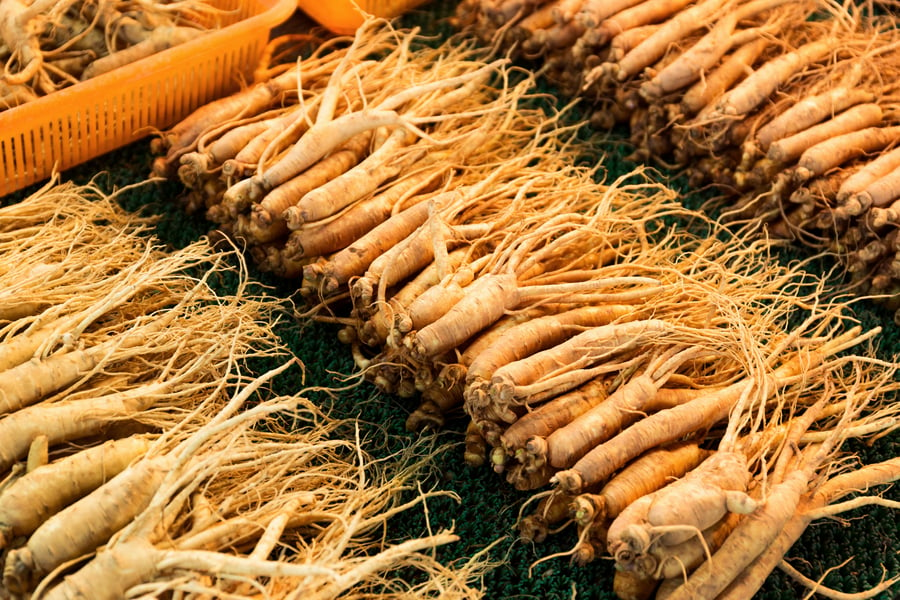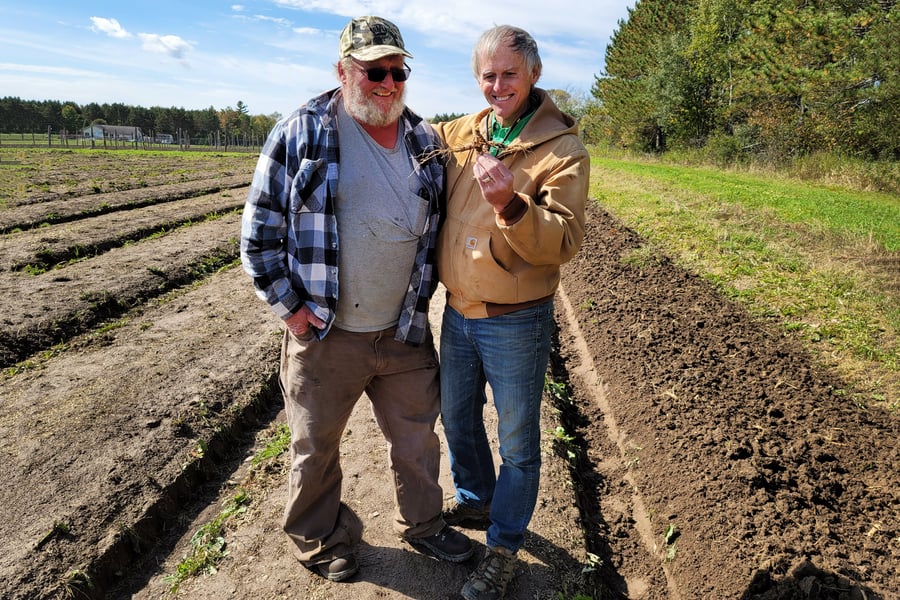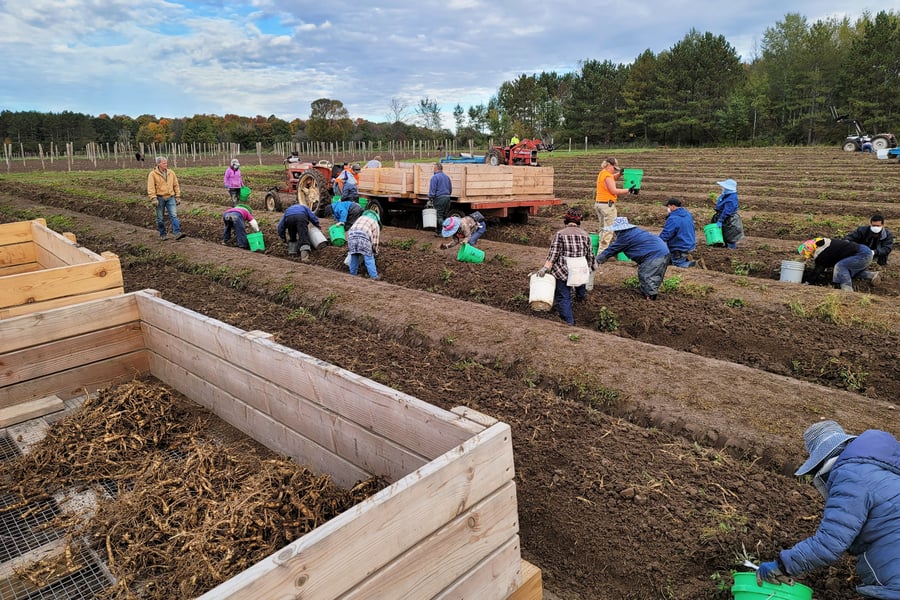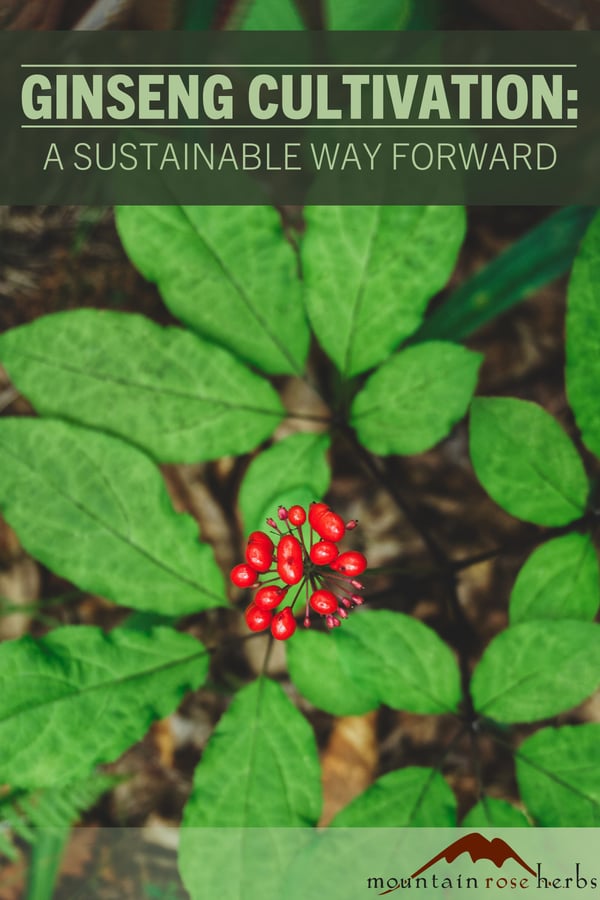
For more than ten years, Mountain Rose Herbs has been working with United Plant Savers (UpS) and other conservation organizations to address the alarming decline in wild ginseng populations in North America. Despite concerted efforts and the support of federal and state governments, as well as ethical ginseng forest farmers and wildcrafters, the state of this precious botanical in the wild remains precarious due to overharvesting and habitat destruction. With that in mind, we are delighted to say that a new way of farming ginseng is providing hope for the future of Panax quinquefolius!
Wild ginseng is listed in Appendix II of the Convention on International Trade in Endangered Species (CITES), meaning it is at risk of becoming extinct if trade is not better controlled. Ginseng is already one of the most legally regulated plants in North America as federal and state governments try to protect and conserve the remnant wild populations. However, there is a lucrative and apparently insatiable market for ginseng, particularly in the beauty and cosmetics industry. 99% of wild ginseng harvested in North America goes to Hong Kong, where it sells for a significantly higher price. As you can imagine, this incentivizes overharvesting and theft.
Forest farming has long been the best hope for a future in which North American farmers could produce enough cultivated ginseng to meet market demand and take the pressure off of wild populations. We are big proponents of forest farming and support it whenever we can. However, it has natural limitations. This wild-simulated method of growing requires access to extensive land and is significantly more work than traditional farming. Seeds are planted in the forest (rather than in tilled soil) at a similar spacing as they would grow wild, and then this slow-growing botanical takes years to become a cash crop, which means the harvest is smaller, and the roots and leaves often cannot be certified organic. The advantage for growers is the wild-simulated element that can potentially fetch a higher price on the international market.
Currently, forest farming cannot produce enough wild-grown ginseng to satisfy demand or put a real dent in the overharvesting and poaching of wild Panax quinquefolius. We, along with UpS, CITES, and others who are passionate about endangered native plants have long said we also need a growing method for ginseng and other forest-grown botanicals that is more in line with traditional farming, which requires less land. But figuring out how to do that wasn’t simple because there was no precedent.
Fortunately, we run in “plant-people circles” and have the good fortune to work with a liaison who connected us to a ginseng farmer who has adapted traditional organic raised bed gardening methods to accommodate the special needs of ginseng. Initially, he faced significant doubt in the community regarding successfully cultivating ginseng. But he is tenacious and passionate about native botanicals, and now his faith and hard work are paying off as he produces increasingly bountiful organic ginseng crops.

It has been a long learning process involving experimentation and adapting to issues as they come up, finding organic ways to resolve problems. For instance, in traditional open-field farm settings like this, we now know ginseng must be grown on new ground. You cannot successfully grow Panax quinquefolius in the same bed or the same soil where it was previously cultivated. This reality is probably a byproduct of monocropping; the current working theory is that the plant leaves a pathogen in the soil. Similarly, we learned that fungal problems can be an issue when ginseng roots grow close together, and it is imperative that soil be well drained. Non-organic farmers deal with fungal problems with conventional chemicals, but on this organic farm, avoiding fungal issues relies on good planting methods and organic interventions.
Serendipitously, there is a Hmong-American community near the ginseng farm, which includes immigrants who came to the U.S. as refugees from Laos during the war in the 1970s. They brought with them generational knowledge about harvesting and processing ginseng. Our farm partner wanted to incorporate this wealth of knowledge in his growing operation and has created a mutually beneficial working relationship with the Hmong contractors who harvest and process the ginseng. They have control over when they work and the power to negotiate what they will earn from the harvest.
Farming ginseng in raised beds requires specialized equipment, starting with bed formers and including special harvesting, washing, and drying equipment. Adequate storage areas are also key to success in making this a marketable crop.
But how does cultivated Panax quinquefolius compare to wild-grown in terms of herbal constituents and taste? There is a perception on the international market that wild is better (hence the high price per pound), but there is no data to back that up. Many botanists and herbalists believe it is unlikely that the constituents are different, particularly when ginseng is cultivated with such care, and we know from personal experience that the flavor of this cultivated ginseng is exceptional. As more people discover cultivated Panax quinquefolius, we will be able to gather more data and anecdotal information.

Wild ginseng has been on the CITES list and under the watchful eye of North American conservation groups and governments for a long time. Unfortunately, the dire situation for this botanical has only gotten worse. If we continue to source from the wild, we are going to tip this plant over the edge of no return and that moment is approaching faster than ever. Cultivating organic forest botanicals like ginseng is imperative.
When you purchase cultivated ginseng root, you are doing your part for the survival of a powerful herbal ally, and supporting U.S. farms and farmers. Next time you replenish your supply of ginseng root or ginseng leaf, we invite you to join us in supporting organic cultivated and forest-grown options.
Note: If you would like to learn more about the history of ginseng and how we now find ourselves scrambling to preserve this powerful herbal ally, we suggest Ginseng Diggers by Luke Manget.














